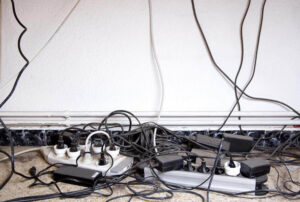There’s a universal moment on every loud job site: someone pulls out their phone, yells “HELLO?” three times into the screen, then gives up with a shake of the head.
That moment? That’s when your phone officially taps out—and a two way radio steps in.
High-noise environments like construction zones, industrial plants, shipyards, and live events don’t just challenge your patience—they break conventional communication tools. Cell phones, Bluetooth headsets, and even voice apps struggle to punch through the chaos.
You need something louder. Clearer. Smarter.
You need a two way radio designed to dominate noise, not lose to it.
Why Phones Fail Where Radios Thrive
Let’s get one thing straight: phones weren’t built for the field.
They’re built for climate-controlled offices, coffee shops, and TikTok. Drop one on concrete or try hearing a call next to a skid steer? Game over.
Even with noise-canceling apps and rugged cases, phones can’t match a high-performance two way radio in loud, real-world environments. Here’s why:
- Voice delay: Phones add lag and audio compression.
- Fragile builds: Screens crack. Mics clog with dust.
- No PTT: Every call requires unlocking, dialing, waiting… seconds that matter.
Two way radios ditch the fluff and double down on immediacy, durability, and clarity.
Loud, Clear, and Instant: Built for the Chaos
Let’s paint the scene.
A generator’s roaring. Rebar’s getting cut. You’re wearing ear protection. And you still need to coordinate a material delivery—now.
This is where industrial-grade two way radios earn their paycheck.
With features like:
- Push-to-talk (PTT) for split-second communication
- High-decibel speakers that cut through ambient noise
- Built-in noise-canceling microphones that isolate your voice from the environment
- Full LTE connectivity so you’re not limited by distance or terrain
LTE-Powered Radios: Nationwide, Not Just Job Site
Let’s say you’ve got foremen at three locations. Or a driver en route with a materials drop. Traditional two way radios hit a hard wall at a few miles—unless you build a network of repeaters (which is fun for exactly no one).
With LTE two way radios, range anxiety is a thing of the past. These radios run on the same high-speed cellular networks as your phone—except they’re optimized for voice-first, real-time team communication.
So even if you’re in a steel refinery in Ohio and your logistics guy is on the highway in Kentucky? One button, and you’re talking.
Built to Survive the Rough Stuff
Phones, tablets, earbuds… nice ideas, but too fragile for the reality of heavy industry.
You need gear that:
- Survives drops from scaffolding
- Keeps working through dust storms
- Laughs in the face of rain and cement splatter
The two way radio is IP-rated, impact-tested, and built for dirty boots and diesel engines—not desk jobs.
And when it finally needs a charge? It uses USB‑C (yes, like your phone—but faster and less annoying).
Who Needs This (Hint: It’s Not Just Builders)
Let’s broaden the scope. If your workplace drowns out normal conversation, you’re a candidate for industrial radios.
Think:
- Airport ground crews juggling jets, luggage tugs, and wind noise
- Warehouse teams operating forklifts and conveyors in echo chambers
- Event production staff coordinating stages, lighting, and sound rigs
- Security teams working concerts, protests, or sporting events
Anytime sound pollution is real and time is tight, two way radios outclass phones—full stop.
No Apps, No Waiting, No Nonsense
In high-noise environments, there’s no time to fumble through apps or wait for someone to “pick up.” You need one-touch communication that works now, not eventually.
That’s what modern two way radios deliver. Instant talk. No rings. No dropped calls. Just push, talk, confirm, move on.
It’s not fancy. It’s just effective. And frankly, in these environments, that’s the only feature that matters.
Final Frequency Check: Ditch the Phone. Grab a Radio.
Phones are smart. Two way radios are smarter for the job at hand.
They:
- Cut through noise
- Survive rough handling
- Cover more ground with LTE
- Keep your team talking without wasting a second
The two way radio isn’t an accessory—it’s essential gear for high-noise, high-stakes work.Because when the machinery’s roaring and the pressure’s on, the last thing you should be asking is:
“Can you hear me now?”




